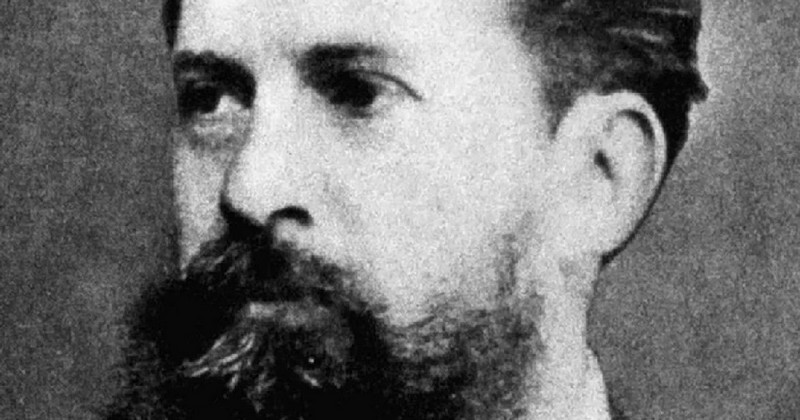Charles Sanders Peirce: biography of this pragmatist philosopher

Along with William James, he was one of the main promoters of pragmatism in the United States.
Charles Sanders Peirce (1839-1914) was an American philosopher and scientist, founder of the school of American pragmatism. He was also a specialist in logic and in the theory of language and communication, which had an important influence on the development of philosophy and also of a good part of psychology.
In this article we will see a biography of Charles Sanders Peirceas well as some of his main theoretical contributions.
Biography of Charles Sanders Peirce: founder of American pragmatism.
Charles Sanders Peirce was born in Cambridge, Massachusetts on September 10, 1839. He was the fourth son of Sarah Mills and Benjamin Peirce, who was. an important professor of astronomy and mathematics at Harvard University..
Like his father, Peirce graduated from Harvard College in 1859 and began studies in chemistry at the Lawrende Scientific School, which was part of the same university. He also served as his father's computer assistant, with whom he did important work in astronomy at the Harvard Observatory.
As part of the same, between 1873 and 1886, Charles Sanders Peirce conducted experiments at approximately 20 space stations in the United States, Europe and Canada. In these experiments he used pendulums of his own design. This brought him international recognition and led him to serve for many years in led him to work for many years as a chemical engineer, mathematician and inventor.. Likewise, his practical involvement in physics led him to finally reject scientific determinism.
In 1867, Peirce was elected a member of the Academy of Arts and Sciences. was elected a member of the Academy of Arts and Sciences, as well as a member of the National Academy of Sciences in 1877.In 1867, Peirce was elected a member of the Academy of Arts and Sciences, as well as a member of the National Academy of Sciences in 1877 and, three years later, he was elected a member of the London Society of Mathematicians.
Thus, for a long time he was active in mathematics and physics, although he had a special interest in philosophy, philosophy and physics. he had a special interest in philosophy, philology, and above all in logic.He is considered, among other things, the father of experimental psychology. He is considered among other things the father of modern semiotics (the science of signs) and one of the most important philosophers of all times.
Peirce's logic
Through his studies, Pierce linked in an important way logic with the theory of signs; although he especially devoted himself to the study of logic in the scientific field or the "logic of science", that is, of induction (how to extract conclusions or principles from a set of data and in a logical manner).
To the latter, Peirce added two methods for generating hypotheses which he called "retroduction" and "abduction". Abduction, for Peirce, is a complement to induction and deduction, i.e., they are tools for generating hypotheses.that is, they are closely related tools.
And he argued that the latter is not only found in the scientific method, but is part of our everyday activity. This is so because, when we are faced with a phenomenon that we can hardly explain, we deploy a range of beliefs that, unable to offer a solution to our doubts, lead us to generate a series of hypotheses about the phenomenon.
We then deduce the consequences of this hypothesis and, finally, we test them by means of experience. This logic allows us not so much to verify which hypothesis is correct, but what each one consists of and how it differs from the others, which leads us to evaluate the whole of its practical consequences.
According to Peirce, all this could only be understandable by means of a broad knowledge of the methods and reasoning present in all the sciences..
Likewise, among the studies he carried out in the logic of science, Pierce analyzed for several years the work of the German philosopher Immanuel Kant, concluding that these were arguments with a logic that Pierce described as "superficial", and that finally led him to formal research in logic, both in philosophy and in other disciplines.
American Pragmatism or Pragmaticism
Peirce argued that the scientific method is one of the resources for constructing and modifying beliefs, as well as one of the most important tools for bringing clarity to complex problems. one of the most important tools to give clarity to complex problems and to offer accurate solutions to them. and offering accurate solutions to them.
In Peirce's pragmatism, every idea has meaning based on its practical consequences, that is, on its experiential value. And in an attempt to differentiate other currents of pragmatism that began to develop from his work, Pierce named his own tradition "pragmaticism", which now serves as a synonym for the school of "American pragmatism" and differs, for example, from the pragmatism of his colleagues William James and John Dewey.
Notable works
Charles Sanders Peirce wrote for more than 50 years on topics related to very different areas of knowledge. From mathematics and physics to economics and psychology, to name a few..
However, probably his two best-known works are the first two articles in a series of six that were originally compiled in Illustrations of the Logic of Science, published in 1877 in the magazine Popular Science Monthly.
These two articles were: The Fixity of Beliefin which defends the superiority of the scientific method over other methods for the resolution of doubts and the formation of beliefs; and How to clarify our ideasin which he establishes a "pragmatic" definition for concepts.
Other of his best known books are Photometric Investigationsof 1878, and Studies in Logicof 1883. In general terms, Peirce's extensive work problematizes questions such as the foundations of modern science, the existence or possibility of attaining absolute truth, and knowledge from a logical perspective.
(Updated at Apr 15 / 2024)